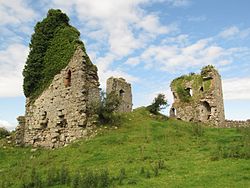Gleaston Castle
| Gleaston Castle | |
|---|---|
| Cumbria, England | |

Gleaston Castle ruins in 2015
|
|
| Coordinates | 54°07′59″N 3°07′57″W / 54.1331°N 3.1325°WCoordinates: 54°07′59″N 3°07′57″W / 54.1331°N 3.1325°W |
| Grid reference | grid reference SD261714 |
| Site information | |
| Owner | private |
| Open to the public |
No |
| Site history | |
| Materials | Limestone and sandstone |
Gleaston Castle is situated in a valley about 0.3 miles (0.48 km) north-east of the village of Gleaston, which lies between the towns of Ulverston and Barrow-in-Furness in the Furness peninsula, Cumbria, England.
The castle consists of the remains four towers connected by curtain walls around a roughly rectangular courtyard. The walls are made of limestone quarried near the site, whilst details such as window and door surrounds are made of a soft red sandstone, the origins of which are uncertain although it is similar to that used in the construction of nearby Furness Abbey. The walls at the southwestern corner of the site have a clay core, as is usual in castle construction, but elsewhere the core is the same shingle mortar used to face the walls.
The castle is first mentioned specifically in 1389, although Sir John de Harrington, 2nd Baron Harington of Aldingham is said to have died at Gleaston in 1369. It is generally assumed that the castle was begun by his grandfather Sir John, 1st Baron Harington at around the time he was summoned to Parliament in 1326. It has been suggested that the Harington family may have found it necessary to move from Aldingham as the sea was eating away at the cliff on which their tower was built. Another alternative explanation is that they needed more room for a greater number of servants.
It is possible that part of the structure is earlier and was built as a defence against the Scots who posed a serious threat to the area following Edward I's campaigns and Robert Bruce's assumption of the Scottish throne. The majority of the castle must surely have been built after the devastating 1316 and 1322 Scottish raids on the area as it was built quickly and poorly, with poor quality local materials, suggesting a lack of funds.
...
Wikipedia

